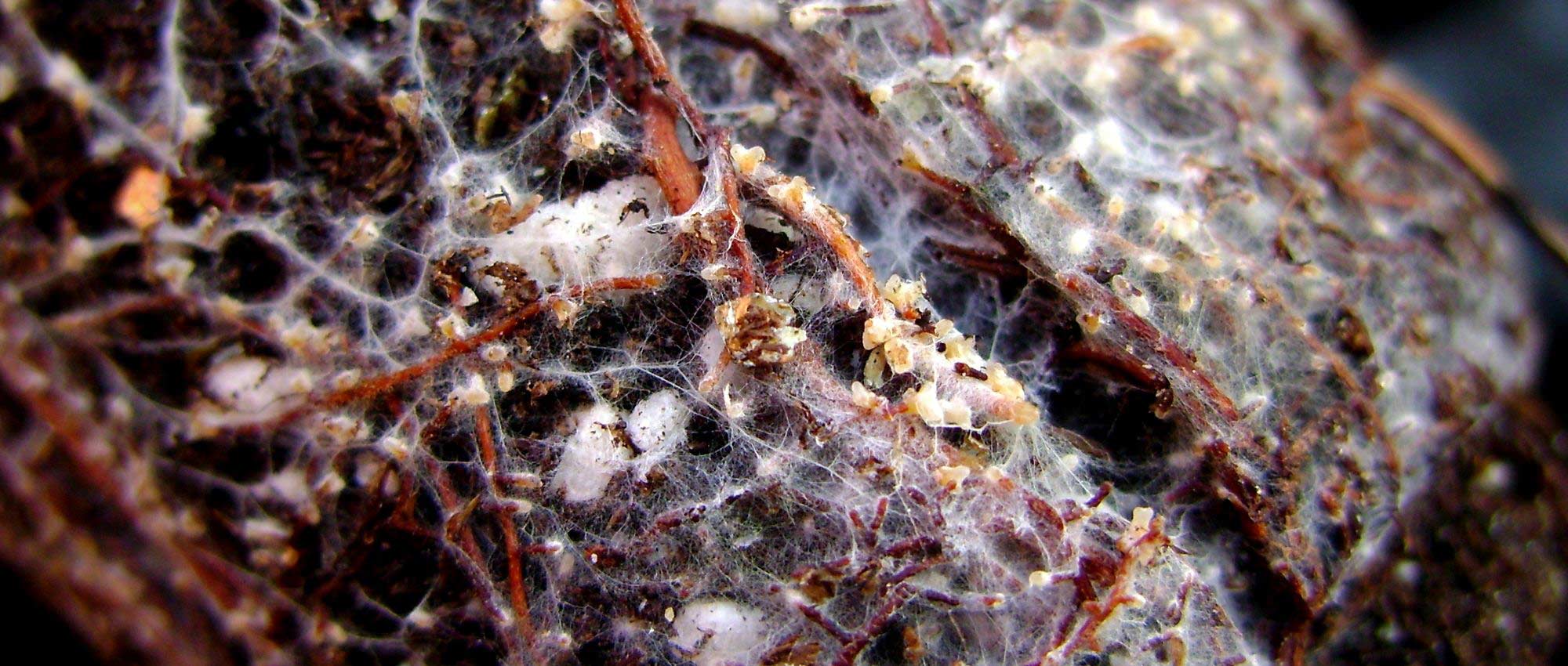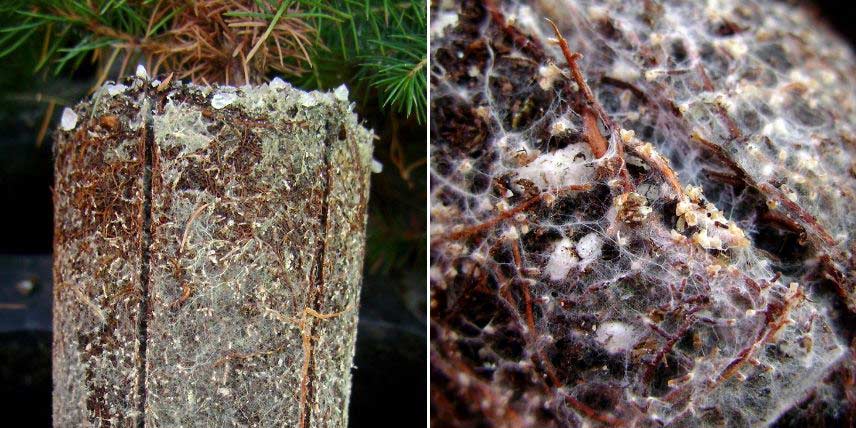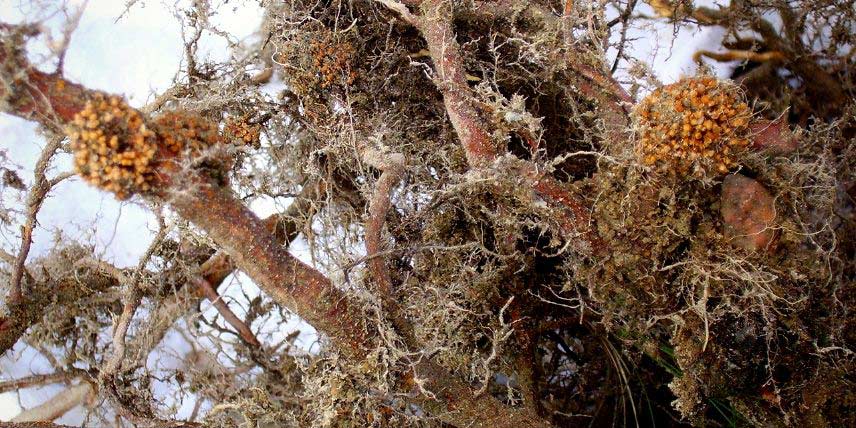
Mycorrhizae: what are they? What are they for?
Explanations and advice for using them in the garden
Contents
Mycorrhizae are a sym symbiosis between a fungus and a plant, which allows both organisms to exchange nutrients. The fungus produces filaments (mycelium) and connects to plant roots to pass on water and minerals it draws from soil. It is a natural, very common phenomenon, but still too rarely used in gardens, although its benefits are numerous. Mycorrhizae form a world that mostly escapes us, because it lies beneath the soil and is made up of microscopic filaments. Discover its importance for plants, its role in the garden, and all our tips to favour this sym symbiosis!
→ Learn more with Olivier’s video on the mycorrhizae
Mycorrhizae: what are they?
The term mycorrhiza comes from Greek myco: fungus, and rhiza: root. It is therefore an association between a fungus and a plant via the plant’s roots. It is beneficial to both organisms.
Fungi reproduce by dispersing their spores. Once in the soil, the fungus germinates and begins to develop mycelia. These enter into contact with the plant, surround the tip of the roots and penetrate them. Most of the time, the fungus enters inside plant cells: this is an endomycorrhiza. After connecting to the plant, the fungus develops a whole network of mycelium to explore the soil and capture mineral elements.
Sometimes it is even possible to observe these mycelia, which take the form of small white filaments. They form a dense, highly ramified network. There is no risk for the plant, because this is not a parasitic fungus. Mycorrhizas are able to link several plants together, thus forming a vast underground ecological network and pooling available resources.
The fungus captures water and mineral elements from the soil, which it transfers to the plant. It forms an extension of the roots and thus multiplies the absorption surface area. It protects the roots and makes plants more resistant.
In return, the plant provides it with sugars that it cannot synthesise. Indeed, only the plant carries out photosynthesis and is capable of transforming mineral elements into organic matter and sugars that can be assimilated by the fungus (elaborated sap). The plant also protects the fungus from pathogenous organisms and attacks.
This is not a rare phenomenon : at least 90% of terrestrial plants develop mycorrhizal sym symbioses. And there are hundreds of species of mycorrhizal fungi. Some of them are well known to us: cepes, chanterelles, truffles… It also sometimes happens that several different fungi graft onto the same plant.
Some fungi can colonise the majority of plants, while others associate only with a single type of plant. Thus the latter have their specific fungi: this is the case for orchids, heathers and rhododendrons, pines, birches, lime trees, beeches… Similarly, there are plants that do not form mycorrhizal sym symbioses.
Mycorrhizas recall the phenomenon of nodosities in Fabaceae: the plant’s roots associate with bacteria that enable it to fix nitrogen. But in this mechanism as well, mycorrhizas are essential to bring necessary resources to the plant.
Mycorrhizas form an extension of the plant’s roots, increasing their exploration range. They thus multiply root absorption surface area by 1,000! Due to their small size, mycorrhizas can explore soil microporosities where roots cannot go. They thus have access to mineral elements that were previously inaccessible to the plant. Moreover, as soon as there is no more water in the soil, the fungus sends a signal to the plant to warn it, which triggers the closure of stomata and prevents the plant from drying out.

The white filaments visible in these photos are the mycelium of mycorrhizas associated with the roots of a Picea glauca (photos: Silk666 / André-Ph. D. Picard)
What are they used for in the garden?
Because mycorrhizae supply plants with mineral nutrients, they act a little like fertilisers, but with a far more lasting and ecological effect. Mycorrhizae are particularly effective at making phosphorus available to plants. They improve plant growth; plants grow faster and are healthier. They enable plants to be grown in soils relatively poor in minerals.
They help plants better resist stresses caused by drought, cold, disease, pests or pollution… There is less risk of plants lacking water or becoming deficient. Mycorrhizae can also produce antibiotics and eliminate pathogenous microorganisms. They stimulate plant immune system and defence mechanisms. Mycorrhizae also protect plant roots from pollution and heavy metals. They can store and neutralise these contaminants.
In vegetable plot and orchard, harvests will be more abundant and of better quality. With improved nutrition, plants will produce more fruit and vegetables, which generally will have more flavour.
Mycorrhizae reduce need for fertiliser inputs and allow watering to be spaced out. Overall, plants require less maintenance and care.
Mycorrhizae promote better establishment after planting and help plants become better anchored in soil. Plants survive more easily when pricked out or transplanted.
Mycorrhizae also help stabilise soil, improving its cohesion and structure. They affect physical and chemical properties of soil and prevent erosion. They are essential for maintaining soil fertility.
Plants growing in poor, dry, polluted ground, in urban gardens, etc. are those that will most need mycorrhizae. Mycorrhizae help them overcome these difficult conditions and find resources in soil necessary to grow. In rich, moist and fertile soil, they are less essential but remain beneficial!
Mycorrhizae also have an ecological role: they allow water to be stored and redistributed to plants in case of drought (sponge effect), they limit leaching of fertilisers and mineral elements, which reduces risk of pollution.

Mycorrhizae attached to roots of an alder (photo Patrick Poitras)
→To find out more, discover the benefits of mycorrhizae for bare-root plantings.
When and how to apply mycorrhizae?
Mycorrhizae are generally sold as a powder to be incorporated into soil. Most plants form associations with fungi of the Glomeromycetes group. Depending on intended use, choose for example mycorrhizae for the vegetable garden, for trees and bushes or for bedding plants and flowers. Mycorrhizae are, of course, usable in organic farming.
Apply mycorrhizae to the garden at time of planting (or at repotting for a plant in a pot). Unlike fertilisers, regular applications are unnecessary: since they are living organisms, a single application is generally sufficient.
To apply mycorrhizae:
- Dig a planting hole appropriate to size of plant.
- Scatter the product in the planting hole so that it ends up close to the roots.
- Remove plant from its pot and tease out roots slightly. You can apply a little powder to outside of rootball. Then place plant in planting hole.
- Cover with soil and firm down with flat of hand.
- Water generously.
It is also possible to apply mycorrhizae to a plant already established in the garden. In that case, make holes in soil near the roots, place mycorrhizae powder in them, then backfill and water.
Note, however, that some plants do not need mycorrhizae: these include brassicas (radishes, cabbages, turnips…), amaranths (spinach, beetroot, chard…), and polygonaceae (Rumex, persicaria, Muehlenbeckia, Polygonum, rhubarb…)… These plants do not associate with mycorrhizal fungi, so applying mycorrhizae is unnecessary! Conversely, mycorrhizae are very beneficial for legumes (beans, peas, lupins…). Likewise, all plants growing on poor or degraded soil, as well as plants in pots or planters, will benefit from an application of mycorrhizae.
If you use fertilisers in addition to mycorrhizae, choose organic fertilisers or slow-release fertilisers. Large applications of chemical fertilisers would reduce mycorrhizal activity (especially those high in phosphorus!). Avoid using fungicides, which can kill mycorrhizal fungi. Where possible, avoid turning over soil so as not to break mycorrhizal networks. In general, soil disturbances (pollution, compaction, ploughing…) greatly reduce number of mycorrhizae. Thus, best way to preserve them is to take care of garden soil!
- Subscribe!
- Contents
































Comments